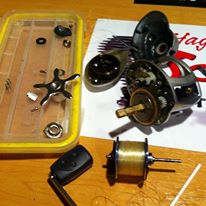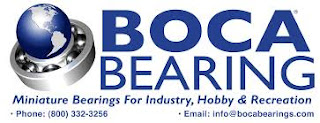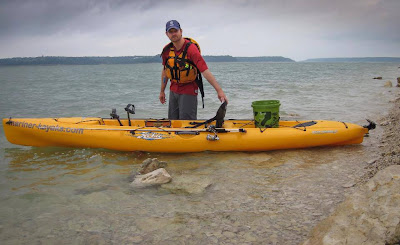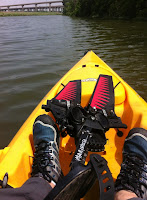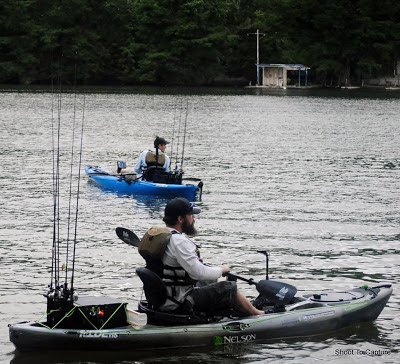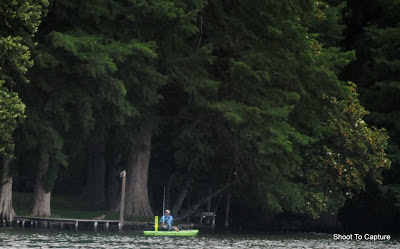6/26/2013
No comments
6/25/2013
No comments
My reel.
I returned home from a few days in the salt and my Abu
Garcia Orra Inshore seemed sluggish. Surf fishing and reeling in 30 pound
Stingrays tends to do that to a mid-range reel.
Me, being the penny pincher I
am (try to be), decided to buy a cleaning kit, watch a How To You Tube video
and clean the Orra myself. Bad mistake. I managed to keep all of the parts
(small miracle) and then posted a distress call on Facebook.
Beau Reed of Papa Chops Rod and Reel Repair said he could
get it back and going again. We were going to be fishing at Lake Austin with a
bunch of folks in a few days so I bagged it up to take it to him.
I got to chatting with Beau around the campfire that weekend
and he asked me if I wanted to do a bearing upgrade with Bocas while he was
fixing my reel. I had always heard about Boca Bearings but never really
understood what they would do for me. Beau talked me through it and I agreed.
A few days later I get a notification on Facebook that I
have been tagged in a new video. The video was Beau, showing my reel completed,
upgraded and then I saw it. Holy Freaking Moses I saw it! He spun the spool on
that Orra and it just kept going. I could have made a sandwich in the time it
took it to stop. He made a $150 reel spin better than any $300 reel on the
market! (For those keeping score, Beau can do most bearing upgrades with a
cleaning for less than $70 total.)
I got the reel back that week and got to fish with it. After
the first cast, I had to relearn what adjustments needed to be made. Usually I
would adjust the drag to where a bait would slowly fall and cast it without
much worry. I learned to do that on my reels because my spool would stop
spinning before it would overrun. With Bocas, the spool keeps going so
different adjustments needed to happen. I tightened down a little more and
minded my thumb a little more and threw that bait, a 4” weightless Hag’s
Tornado (plastic worm) twice if not three times farther than normal.
Two to three times farther!
I have always kept a small arsenal of spinning gear because
I liked the distance I could get when casting weightless soft plastics. I am
seriously reconsidering that now. On Thursday, I have more work being done by Beau
at Papa Chops Rod and Reel Repair and you’re absolutely right if you guessed
Boca Bearings will be involved. Want to see a video with the reel he Boca'd? Check it out here:
(You'll need to either friend me or like the page to see it. )
Do you have a favorite reel that needs a make over? Do you
have a newer reel that you want to sing when you cast it? Give Beau a call at
512-294-3155. Ask him for the Boca Treatment. Saltwater reels? No problem.
Freshwater reels? Of course!
Got something to add? Hit me up on Facebook! Want to know when a new article is up? Click on the Follow This Blog button on the right. Want the Monthly Newsletter? Click on subscribe to the left. Don't forget to follow PPF on Facebook at https://www.facebook.com/PaynesPaddleFish and on Twitter @paynefish. - See more at: http://www.paynespaddlefish.com
6/20/2013
No comments
 Summer is here. Especially in the South. As the temps rise, the populations of ski boats and jet skis do as well. Some hard core kayak fishermen brave the Beyond the Breakers style wave action at places like Lake Austin but others prefer to wait for night fall.
Summer is here. Especially in the South. As the temps rise, the populations of ski boats and jet skis do as well. Some hard core kayak fishermen brave the Beyond the Breakers style wave action at places like Lake Austin but others prefer to wait for night fall.Oh night. That cooling, non-sunburning, top water bass time of year. More and more folks want to try night fishing and I don't blame them. It's becoming a hot topic again so I wanted to share some info on some things that can help your adventure. We'll skip the legal talk this time (though it is linked below) and get straight to the goodies.
The first thing you are going to need is a 360 light. We've discussed it quite a bit lately but it is very important. For the ins and outs of the law, please visit this link. I have used both the Scotty C-Light and the YakAttack VisiCarbon Pro. The VisiCarbon is far superior, incorporating a brighter light, foldable pole and attached flag. If you want to be seen on the water, this is your first step.
Now you can be seen but can you see? The next recommendation is a head lamp. When you are loading or unloading the kayak, tying knots or trying to see in a certain direction, a headlamp can help a ton. The first order of business is which one. If you look at different packages, you'll see a rating called a lumen. Some lights are 40 lumens, some 200+ lumens. Lumens are the measure of light produced. That $15 special that has 25 lumens, you should leave it alone. A match would almost produce that much light. Headlamps also come with optional strobes and colors in some of the higher end models. I like a red light for tying and it doesn't attract as many bugs. If you want a programmable, multi-function headlamp, check out the Petzl Myo-RXP. It runs about $90 and you can check one out at your local REI or order online.
Headlamp not going to cut it? Need more! I have a solution for that as well. Why not outfit your kayak with some 5050 LEDs? Fully customizable from certain shops, the best in the business is Dez Davis at SuperNova Fishing Lights. He can custom make you a kit for exactly what you want whether it be cabin lights, fishing lights, nav lights or deck lights. If you can dream it, Dez can help you find a solution. If you are ordering lights online, best know what you are getting into. To get educated, check this link.
Make sure you are safe and legal, get you some goodies and get out on the water while the night fishing is hot. Hearing a bass suck down a frog in the dark is something to be experienced. Give it a shot!
Got something to add? Hit me up on Facebook!
Want to know when a new article is up? Click on the Follow This Blog button on the right. Want the Monthly Newsletter? Click on subscribe to the left. Don't forget to follow PPF on Facebook at https://www.facebook.com/PaynesPaddleFish and on Twitter @paynefish.
6/19/2013
No comments
Special thanks to Josh Neumeyer for compiling all of this info. Josh is a seasoned kayak angler on both fresh and salt water. He has worked diligently to compile a succinct and easy to read list. Please read through these, know them and obey them. It could save your life or someone else's.
Minimum Requirements for Kayaking in Texas
PFD (aka Lifevest) Requirements
Distress Signaling Devices - Audible & Visual
Light Requirements
Registration and Numbering
Minimum Requirements for Kayaking in Texas
PFD (aka Lifevest) Requirements
- You must have a Type I, II, III, or V PFD for each person on the kayak [TWSA Title 4 § 31.066(a)][CFR Title 33 § 175.15]
- Children under the age of 13 must always wear their PFD [TWSA Title 4 § 31.066(b)][CFR Title 33 § 175.15(c)]
- Type V PFDs must be used in accordance with the manufacturer's label to be legal [CFR Title 33 § 175.17(a)]
- Inflatable PFDs may only be worn by adults over the age of 16 and weighing more than 80lbs [CFR Title 46 § 160.076]
- All PFDs must be in good, serviceable condition without any cuts, tears, rotten material, etc [CFR Title 33 § 175.23]
- All PFDs must fit each person properly [CFR Title 33 § 175.21]
- Each PFD must be readily accessible to each person [CFR Title 33 § 175.19]
Distress Signaling Devices - Audible & Visual
- On inland waters you are not required to have an audible signaling device [TWSA Title 4 § 31.073(a)]
- On coastal waters you must have an audible signaling device capable of making efficient sound [USC Title 33 Chapter 34 § 2033(b)]
- You are not required to have visual distress signaling devices on inland waters [TWSA Title 4 § 31.073(a)][CFR Title 33 § 175.5]
- You are required to have USCG approved visual distress signaling devices suitable for night use when kayaking between sunset and sunrise on coastal waters [CFR Title 33 § 175.115]
- Visual distress signaling devices must be readily accessible [CFR Title 33 § 175.120]
- Visual distress signaling devices must be in serviceable condition [CFR Title 33 § 175.125]
Light Requirements
- You must exhibit at least one bright light, lantern or flashlight visible all around the horizon from sunset to sunrise in all weather [TWSA Title 4 § 31.064]
- All-around white lights must be visible for 2 miles [USC Title 33 Chapter 34 § 2022(c)]
Registration and Numbering
- Kayaks, regardless of length, do not have to be registered [TWSA Title 4 § 31.022(c)]
- Kayaks, 14 feet or longer, equipped as a sailboat have to be registered and numbered [TWSA Title 4 § 31.022(c)]
- Kayaks, regardless of length, equipped with a motor (electric or gas) have to be registered and numbered [TWSA Title 4 § 31.021(a)]
- If you register and number your kayak know that there are more minimum requirements that apply than listed above
6/17/2013
No comments
In a word the Hobie Mirage Revolution 13 is: Fast.
From the moment I engaged the Mirage Drive in the Revo 13 I
knew I was sitting on a rocket. I had the Turbo Fins locked in and could blaze
through the water with ease. The Revo has so many upsides it’s a wonder more
people don’t fish out of them. As with any testing period, I located some areas
for improvement as well.
The morning that taught me everything I needed to know about
this kayak started at 5 AM. The moon was covered by clouds and the sun wouldn’t
make its appearance for another hour and a half. I could feel the wind and know
that the reported 15mph didn’t quite cover it. 25mph was more accurate though
in the dark it was hard to tell. The forecast said the wind would be dying out
over the next few hours and the hybrid bite was on so, PFD strapped on, lights
ablaze I set off into the darkness on my half mile journey. As soon as the
kayak gained buoyancy the wind caught it. I deployed the rudder, pointed the
bow into the wind and used the paddle for about 10 strokes. I quickly dropped
the Mirage Drive into place and went to work pedaling. Waves crashing over my
bow and around the sides told me quite a bit. The rudder held me on course, the
Turbos sliced me through the water and a short time later I had made my
destination. I had to turn broadside to the waves for about 100 yards and I
learned a little more. This weather, though not ideal, was simulating lots of
situations that would normally take several weeks to experience. Sheltered and
safe, I commenced fishing and for once the forecasts were correct. The wind
died to a mere 10mph and the trip back was uneventfully quick. I was able to
make two other trips in the boat but none proved as useful as this one.
The Good
The Revo 13 is F-A-S-T! I covered the same water I used for
one of the Slayer 12 trips and did it in ½ the time. Over 13 feet of kayak
helps keep you on course but add in the rudder which comes standard and this
kayak will move. Add Turbo Fins and it flies! It will also turn more easily
than boats of equal length. The hull weight of just over 69 pounds seems about
right or even on the lighter than expected scale. Three hatches allow under hull access and
provide a good place to store extra tackle, gear or clothes. Come to think of
it I am pretty sure I left a box of Storm swimbaits in the Revo I tested. The
boat drains quick. I really needed it on the nasty weather trips and it didn’t
disappoint.
Room for Improvement
The Revo is a skinnier version of its shorter big brother
the Outback. At only 28.5” wide it doesn’t handle broadside waves as dryly. I
missed not having the side trays or wider side rails for mounting Gear Trac. I
could only feasibly find a couple of locations to fit a 4” Trac and it would be
a bit of a stretch at that. The hatches offer access but a major improvement
would be to add the Pro Angler rectangular hatch, maybe slightly smaller where
the center round hatch is. As it is now, you can only get longer gear like
poles or paddles in through the front. That’s ok for lakes, not great for BTB
trips. Because the kayak is narrower, if you are pedaling quickly and do a
sharp turn with the rudder control, it
gets pretty tipsy. I’m not sure how many times you would do that but it leaves
a little to be desired with width stability. I wouldn’t stand in this Hobie.
Only the PAs are made for standing but the Outback and Sport are standable
models. The keel is less pronounced in the Revo than the Outback and Sport
which I feel makes the difference.
Final Thoughts
So the end all question is would I buy one? Yes. I would.
Would I buy it over an Outback? Not for my uses.
The Revo is an excellent boat and should be very popular for
car toppers everywhere. The weight of the hull feels lighter than 69 pounds and
it flies when in water. It is a possible
BTB kayak though the shorter model might be preferred by some to avoid telephone
poling on re-entry. I wish it were two inches wider and had a rectangular
center hatch. Past that, it’s dang near perfect for folks who don’t mind
sitting in a more traditional style kayak seat.
6/10/2013
No comments
Nearly 128 million Americans have smart phones now according to Pew and Nielsen. That is approximately 50% of the US population. Of those numbers, you have a lot of kids under the age of 10 so the %ile goes even higher. I am going to go out on a limb and say if you are reading this blog, you probably either have one or know someone very close to you with one. That's a pretty sturdy limb.
Solunar Tables- Solunar Calendar by Solve the Puzzle A/S
Navigation- Marine&Lakes: US&Canada By Navionics
This app has saved me several times. From boat lanes to topo maps, it has everything I could ever need. At $15, some people balk at the price but to get this chip for a handheld or fishfinder it's $100. I figure I am getting an 85% discount and who doesn't love that? If you need to mark those spots where you are slaying fish or mark a route through that mangrove forest, this is your app. Waypoints are limited only by storage and if you have that many waypoints you need to share some with me. Not only do you get regional coverage but anywhere you draw a box around in the US and Canada, it will download all the info. Super sweet for the budget conscious.
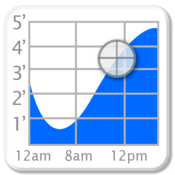 Tides- Tide Graph By Brainware
Tides- Tide Graph By Brainware
Want to know when the tide is moving? Checkout Tide Graph. I've been using this app for about 18 months and it is very accurate. You can select different points along coast lines and know exactly when the fish are going to be moving. For $2 you won't have to trust that printed card for accuracy. You can pinpoint where you are going to be and know exactly what's going to be moving and the rate. If you are fishing in salt even once a year, this will be the best $2 you spend. If you couple this with the solunar table, you'll find some hungry fish. This isn't just innovation, it's information at your hands when you need it.
As I implied earlier, this is not the end all be all list but it has definitely improved my fishing over the time I have had a smart phone with these apps. Learn to read them and the water is your oyster. Open it up and see what you find. Additional apps you find helpful are more than welcome in the comments section and are encouraged.
Do you have an app you'd like everyone to know about? Post up a comment here, on Facebook or even Google+!
So now the question is not do you have one but rather, are you utilizing its full potential?
Traditionally cell phones and water sports don't mix but as a kayak fisherman you may be missing out on some things that could give you an advantage at tournament time, cut homework in half for fishing prep, make sure you don't get a fine for launching in the wrong place and tons of other information and add-ons that will make you a mobile intelligence station.
The first thing you need is phone protection. Options are going to vary depending on the phone you have. The things you need are a case that is as water tight as possible and possibly a dry bag for it. Here are my recommendations based on trial, error, frying a phone, and feedback from other paddle/fish friends.
iPhone 3GS or 3 and HTC EVO/ Android Phones-
| OtterBox Defender |
The OtterBox Defender, $40. I have used this case for quite a while. It doesn't claim to be waterproof but with three layers does a good job of making it tough for water to get to the phone. Couple this case with a Dry-Lock bag and you are good to go. Through the three layers you can still use the phone's touch screen and not worry about moisture on your hands. It's a really good case for the money and the rubber backing will hold it in place on a dash board, console or wherever. These come in multiple colors so go wild! Just remember, it doesn't float.
 |
| LifeProof case |
iPhone 4, 4S, 5-
LifeProof case, $80. This is a case I have seen in action multiple times. This one is water proof, shock proof, dirt proof, toddler proof (I added that), and a variety of other things. With this case you don't need a Dry-Lock bag at all. Keep it in your pocket, your jacket, whatever and it will keep on ticking. If I had an iPhone 4S (come on October!), I would put it in this case. "But wait (he says in an infomercial voice), there's more!"
Also available from LifeProof is a LifeJacket for your LifeProof case. Drop it in the water and yes, your phone and the $600 you've invested in it floats at the top of the water awaiting your rescue. Finally! How long have we needed this!
Now that your phone is protected, we need to talk about how it can be of more use than just the boss calling. Myriad apps exist that are supposed to make fishing, paddling and the like easier but in actuality, most of them are junk. I have waded through several that were so cumbersome that I wanted to throw my phone in the lake. I am going to help you out and give you the best of the best that I have used. These are not the only apps that work but for a paddle/fisherman, these are three that I use and recommend.
This app syncs the solunar tables into your calendar based on your location and can set reminders. It will tell you when to fish or when to just paddle. It's designed for iPhone and works with older and newer iOS. For 99 cents it's handy to never have to find a copy of Field & Stream at a gas station. I saw one rating in July that said "Outstanding", usually it would be "Excellent". I had never seen that description before and the fishing was on that day.
This tool is nice to have because it gives corresponding moon and sun times and works for the coast or the lake.
This app has saved me several times. From boat lanes to topo maps, it has everything I could ever need. At $15, some people balk at the price but to get this chip for a handheld or fishfinder it's $100. I figure I am getting an 85% discount and who doesn't love that? If you need to mark those spots where you are slaying fish or mark a route through that mangrove forest, this is your app. Waypoints are limited only by storage and if you have that many waypoints you need to share some with me. Not only do you get regional coverage but anywhere you draw a box around in the US and Canada, it will download all the info. Super sweet for the budget conscious.
 Tides- Tide Graph By Brainware
Tides- Tide Graph By BrainwareWant to know when the tide is moving? Checkout Tide Graph. I've been using this app for about 18 months and it is very accurate. You can select different points along coast lines and know exactly when the fish are going to be moving. For $2 you won't have to trust that printed card for accuracy. You can pinpoint where you are going to be and know exactly what's going to be moving and the rate. If you are fishing in salt even once a year, this will be the best $2 you spend. If you couple this with the solunar table, you'll find some hungry fish. This isn't just innovation, it's information at your hands when you need it.
As I implied earlier, this is not the end all be all list but it has definitely improved my fishing over the time I have had a smart phone with these apps. Learn to read them and the water is your oyster. Open it up and see what you find. Additional apps you find helpful are more than welcome in the comments section and are encouraged.
Do you have an app you'd like everyone to know about? Post up a comment here, on Facebook or even Google+!
6/05/2013
No comments
Saying I’m a blogger just sounds cool to lots of folks. When
I tell people I have a fishing blog, it invokes lots of faces from surprise to
admiration. Telling them that it’s more specifically a kayak fishing blog
usually puzzles them. “How many people would actually read a kayak fishing
blog?” is what their faces say. The fact is, every segment of hobby, craft,
sport and trend has a following. A niche.
Millions of people like to read blogs. Those same people
often have thoughts and opinions they would like to share too so in turn millions
of people have blogs. Or at least
they start one… or three. The concept seems simple enough: I’ll write whatever
I want and lots of people will come and read it.
Wrong.
Your mom might read it. And some of your Facebook friends if
they get around to it. You might get a few dozen visits the first week. You’ll
be happy. You’ll write some more. People may or may not show up. The post you
thought would intrigue the world got 24 views yesterday. You expected 2400. It’s
discouraging so maybe you’ll take a short break from writing your new blog,
really gather up some good stories, do an interview or maybe a review. Three
weeks later you realize you haven’t written anything new and your next post
gets five views. Five. “Maybe it’s not for me,” or even “I don’t have time to
do this like I want to,” will play through your mind. Two months after it
started, your blog is dead.
I know all of this because I have lived it. I’ve bought
dozens of domains, started countless blogs and only one has stuck around more
than three months. This one.
Do you know why? I finally learned the secret. Actually
several of them but it all starts with one.
Here it is: You CANNOT be a good blogger, have a following,
be read and published if you treat it as a casual relationship. You must be
married to your blog. Your blog is your brand. To do it right, it must be a
job. And you have to perform your job well. People may only know you through
what you present on your blog so make it a good impression.
A few simple steps will help guide you on your way. Follow
these and you will at least have the formula down. The execution is up to you.
Step 1: You need a catchy name. Debbie’s Mom Blog or Pete’s
Fishing Blog are too generic and not easy to remember. Trying something like
Pat Kellner did: Fish Tattoo. Catchy right?
Step 2: Branding. You need a good logo. It has to say what
you are about without having to list it. If you are writing about kites, have a
kite of some sort in your logo. It makes an impression that is then associated
with your blog.
Step 3: Design. The typical free design template default
from Blogger or Wordpress is not going to get it done. Plenty of fresh
templates exist for free or a small price that can help set you apart. And when
you are selecting fonts, Comic Sans is only acceptable…never. It’s not cute. It
tells everyone you don’t take this seriously. Try a Garamond or a Century font.
Step 4: Content. Have a vision of what you want to do. Write
it down. Write down all the blog entry ideas you can think of. Talk to friends
and see what they would be interested in. You also have to know your audience.
My kayak fishing blog readers typically are not as interested in String Theory
Applications in Physics as they are about a new adventure in a just released
kayak from Manufacturer X. Write for you but also write for them.
Step 5: Write on a Schedule. You need to be predictable in
your writing schedule. And you need to stick pretty darn close to it. More
frequent is ok if it is good content but writing less frequently is the nail in
the coffin. Pick a number like once a week or twice a week that you know you
can keep up with and stick to it. Your audience doesn’t know and really doesn’t
care about sick days or long vacations. The more predictable and consistent
your writing and publishing, the more people will visit. (If your content is
good).
Step 6: Power Through. You will hit a wall. You will not
feel like writing. You will think about taking a break. DON’T! This is where
the work part comes in. This is a job. People are anxiously awaiting your
newest post on Tuesday at Lunch. Give it to them!
Step 7: Cross Promote. If you don’t like social media,
blogging probably isn’t for you. To grow your audience you need to be where
they are. Blog readers are on social media! Sign up for a Facebook account,
create a page, get a Twitter account and do the same. If you really want to get
your social media presence going get on Pinterest, Linked In, Tumblr, Vimeo,
You Tube and tons of others. It is also good to visit forums with like-minded
people to let them know you have some content that is free to check out and you
would appreciate feedback.
Step 8: Be Thick Skinned. When someone flames your blog, hates what you
are doing, leaves nasty comments and says you’re dumb, just stay calm. Keep in
mind this is not actually a personal attack. It is an attack on a thought you
put out there. People disagree all the time. We’re humans after all. Free
thinkers. The most controversial stuff you post will often generate the most
traffic. Keeping your head about you during controversy furthers your brand
image. Keep cool.
More steps exist but these eight are a good start. If you
can do all this, you might have a shot at carving out your own little corner of
the internet. If not, that’s fine too. At least now you’ll know going in what
you are embarking upon.
Have more questions? Hit me up on Facebook at https://www.facebook.com/PaynesPaddleFish
or Twitter @paynefish
Know someone who wants to start a blog? Share this with
them!
6/03/2013
No comments
Autumn Villanueva of Shoot to Capture, our photographer capturing the 1st Annual Texas Kayak Bass Fishing Conference had some amazing shots that I thought captured the scenery, comraderie and overall feel of the event. I'll let the pictures speak for themselves. Click on them to get a bigger picture.
(Published with permission)
(Published with permission)
6/03/2013
No comments
Sometimes it all just comes together. A Facebook post asking about a fishing spot goes viral and before you know it an entire event is formulated. Even more impressive than the turnout was the geographical reach that a little get together had.
 The seed planter, Walker Nelson of Nelson Custom Rods, had no idea an inquiry about fishing would turn into what it did. With fishing writers, industry trades folks and kayak fishermen from all over Texas wanting to get together, the resulting weekend gathering needed a name. After much thought it was deemed the 1st Annual Texas Kayak Bass Fishing Conference hosted by Keep Austin Fishing.
The seed planter, Walker Nelson of Nelson Custom Rods, had no idea an inquiry about fishing would turn into what it did. With fishing writers, industry trades folks and kayak fishermen from all over Texas wanting to get together, the resulting weekend gathering needed a name. After much thought it was deemed the 1st Annual Texas Kayak Bass Fishing Conference hosted by Keep Austin Fishing.
The KAF folks are a group on Facebook who promote kayak fishing in the Austin area. Known to frequent Lady Bird Lake, Lake Austin, the Lower Colorado and more, Jesse Reynolds, Beau Reed, Chewy Linton and others bring true passion to the sport.
I met Jesse over the winter months when I inquired about fishing Lady Bird Lake. He met me at the ramp and proceeded to show me several great spots to fish. He didn't have to but that's just the kind of guys the crew at Keep Austin Fishing are.
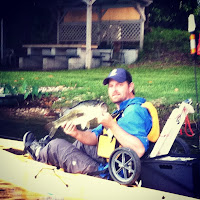 |
| First Lake Austin Bass. 20.5" |
While the fishing was pretty good, the real gem of the event for me was the campfire discussions. Having such a wide variety of people from different walks of life makes for great stories and lessons. I learned a lot about rod building, reel repair, fishing techniques, kayak preferences and more. I got to visit with Michael Lammers about my Native Slayer review. Michael has a Slayer and confirmed what I thought to be true: The preferences of the fisherman really dictate whether or not the Slayer is a good fit. That seems pretty simple and applies universally but it was good to see the kayak had made him happy and fit the bill for what he wanted. The thing I really enjoyed about the conversation is the open exchange of information and being able to see things from different perspectives.
Marcus Villanueva and his wife Autumn of Shoot to Capture were there and she captured some great photos of the event. Having good photos to capture the event was a huge added bonus! For you guys that missed out, if you're on Facebook, check them out here.
 I finally was able to meet some folks like Bobby Clark I had known through forums and the like for quite a while and get some time on the water with Will Norvell, Jerry Hamon, KJ (Kevin Jackson) and of course Walker. I also had some great conversations about lighting with Dez Davis of Supernova Fishing Lights and Lance Nickel who just moved back to the area less than a month ago.
I finally was able to meet some folks like Bobby Clark I had known through forums and the like for quite a while and get some time on the water with Will Norvell, Jerry Hamon, KJ (Kevin Jackson) and of course Walker. I also had some great conversations about lighting with Dez Davis of Supernova Fishing Lights and Lance Nickel who just moved back to the area less than a month ago.
I can't express my appreciation enough to KAF, Beau at Papa Chops Rod and Reel Repair and everyone else involved for getting this up off the ground and for helping this become such a great time. With plans to continue doing this, I can't wait to see what the next one holds, where it will be and who will be the host.
Subscribe to:

